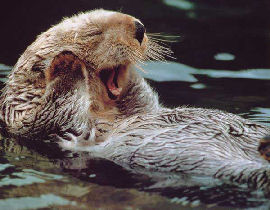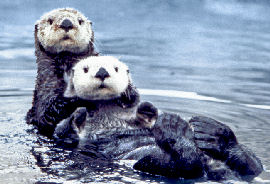Otters
Description
Dark brown; head and back of neck yellowish or grayish. Old males may have white heads. Fairly short tail, thick at base, gradually tapering. Feet webbed; hindfeet flipper-like. Male somewhat larger than female. L 30–71" (760–1,810 mm); T 10 1/4–14 1/4" (260–360 mm); HF 5 7/8 –8 3/4" (150–222 mm); Wt 25–80 lb (11.4–36.3 kg).
Endangered Status
The Southern Sea Otter, a subspecies of the Sea Otter, is on the U.S. Endangered Species List. It is classified as threatened in California. Once an abundant species, the Sea Otter was so heavily hunted for its highly prized pelt that by 1911, when an international treaty forbade its massacre, it had nearly become extinct. The animal was not seen in California for many years, but in the spring of 1938, a herd appeared in the sea south of Carmel. Today the population there is perhaps 2,000. The southeast Alaska-Washington population seems to be holding steady, with the exception of the region where the Exxon Valdez oil spill wiped out thousands. The very large herds found in the Aleutian Islands have lost some 70 percent of their numbers in recent years, and the Aleutian population is now a candidate species for endangered status. Killer Whales are believed to be the culprits, feeding on Sea Otters because their traditional prey species, the Northern Sea Lion, has become rarer. There is an ongoing controversy between fishermen and conservationists concerning the Southern Sea Otter. Conservationists want to keep the animal on the Endangered Species List to ensure its protection, but fishermen want to control the Sea Otter in order to limit damage to abalone populations.
Sign
A loud, rapid tapping: the sound of
shellfish being cracked open on stones.
Scat: When fresh, massed
or cylindrical, thick, 4–5" (100–125 mm) long, containing bits of
shellfish or shell; crumbles easily. Occasionally found on
beaches.
Tracks: Rarely seen. Hindprint fan- shaped, 6" (150 mm)
long, almost equally wide at front. Foreprint smaller,
roundish.
Habitat
Coastal waters within a mile (1.5 km) of shore; especially rocky shallows with kelp beds and abundant shellfish.
Range
Pacific Coast from California to Alaska.
Discussion
Highly aquatic, the Sea Otter eats, sleeps, mates, and even gives birth at sea, and can remain submerged for four to five minutes. Flipper-like hindlegs make the species clumsy on land; it takes to the beach only to wait out storms. By day, the Sea Otter feeds while floating on its back, sculling with its tail. If in a hurry, it swims on its belly, using its feet and tail like a Northern River Otter. At night, the Sea Otter wraps strands of kelp about its body to secure its position in the kelp beds where it sleeps. Unlike other oceangoing mammals, the Sea Otter has no insulating blubber; air trapped in its fine fur keeps it warm as well as buoyant. If the fur is damaged in an oil spill or by other pollution, the otter can die from exposure or cold. The Sea Otter is a greater user of tools than any other mammal outside the primate family. When it dives for food, it also brings up a small rock. It then floats on its back, places the rock on its chest, and cracks the shell against it. Abalone, sea urchins, crabs, mussels, and fish are the chief foods of this species. A playful animal, the Sea Otter may interrupt a meal to dive and frolic underwater; it consorts amiably with seals and sea lions, sometimes touching noses. The Sea Otter watches for danger by standing in the water and shading its eyes with both forefeet; if it spots such predators as sharks and killer whales, it hides in kelp beds. Sea Otter pups are weaned at one year, but may remain with their mother even after she has a new pup. The mother floats on her back to let her offspring nurse, nap, and play on her chest. When alarmed, she may tuck her pup under a foreleg and dive for safety.




